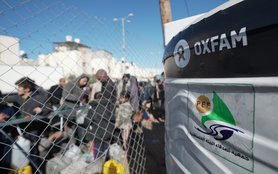International aid organization Oxfam and leading West African farmers network ROPPA today welcomed the initial forecast of an improved harvest in the Sahel region but warned governments and the UN that the food crisis is far from over and an increase in aid is still needed to help farmers and herders overcome the triple challenge of recurrent droughts, persistent poverty and political instability. The forecast was made today by a group of West African regional bodies monitoring food security and UN agencies including the World Food Program.
“This initial forecast of a better harvest is welcome news but governments, the UN and aid organizations should not see this as an excuse to take the foot off the accelerator. For millions of people, the food crisis is far from over. Food prices remain sky high, incomes have been exhausted and millions will continue to require support to recover. It would be madness to walk away at the first sign of improvement. We would lose the hard fought gains made so far, and undermine the ability of people to get back on their feet and build a future,” said Al Hassan, Food Security Policy Coordinator for Oxfam in West Africa.
While initial estimates for the coming harvest appear to be above average, and would allow an improvement for many people across the region, not all areas are faring well. In Mali, the government estimates that production this year could be reduced by 20 to 30 percent. Even in a good year, 20 percent of the population go hungry and 230,000 children die from hunger-related causes.
“Many farmers are thankful for better times ahead, but many others were unable to plant successfully or have seen their crops hit by flooding. To exit this food crisis, farmers will need seeds, tools and fertilizer to help them grow crops this coming winter as well as support to increase yields for years to come. Then we have to stop this crisis from happening again. The needless loss of life and suffering should spur governments to start proactively addressing the root causes of these problems,” said Djibo Bagna from ROPPA.
Although rainfall has been good in most areas, it has been poor in pockets of Niger, Chad and Senegal, while serious flooding has also hit some zones, destroying, for example, thousands of hectares of land in Niger, Chad, Nigeria and Senegal. There remains poor pasture for livestock in parts of the north of Senegal, in the south-east of Mauritania, in the east of Burkina Faso, the north-east of Nigeria, the region of Mopti in Mali and the regions of Tillabery and Tahoua in Niger.
Many farmers have not been able to take advantage of the rainfall due to the current food crisis. Required emergency aid to agriculture was only 24 percent funded, and aid organizations have only been able to provide enough seeds, tools and fertilizers to less than half of the 9.9 million people targeted.
Food prices also remain extremely high across the region. In August, the price of millet was 62 percent higher than the last five years’ average in Niamey, Niger and 73 percent higher in Ouagadougou, Burkina Faso. In Bamako, Mali was 96 percent higher than the last four years’ average.
There is also the threat of a locust invasion in parts of the region, especially in Mali where control efforts are more difficult by security concerns. The risk will be especially higher from mid-September to October, when swarms could form, migrate and threaten the crops.
Continued instability in Mali and increased stress on displaced people and host communities inevitably provide additional challenges and needs. Rice production in northern Mali could be at just 30 percent of a normal year and in some areas half of all livestock could be lost in due to insecurity preventing migration, a lack of animal feed and veterinary services.
Oxfam and ROPPA said this is the third large scale food crisis to hit the region in less than a decade. To prevent the next drought from becoming a humanitarian emergency, donors need to support investment in the capacities of small scale producers, social welfare programs and food reserves that would enable rapid responses to future crises and help communities manage volatile food prices.


